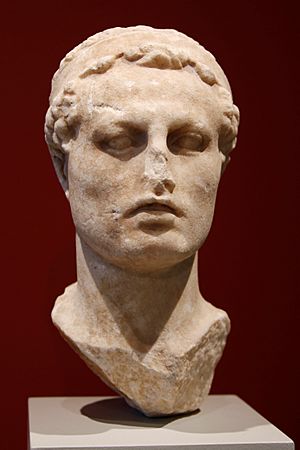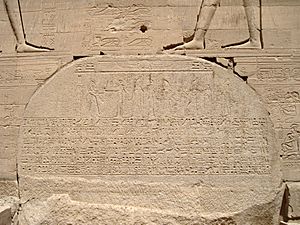Ptolemy VI Philometor facts for kids
Quick facts for kids Ptolemy VI Philometor |
|
|---|---|
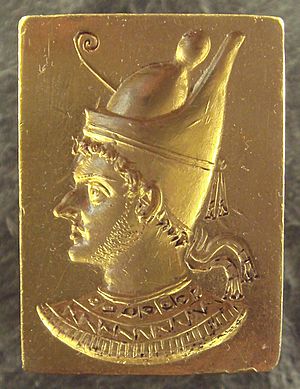
|
|
| King of the Ptolemaic Kingdom | |
| Reign | 180 – 164 BC 163 – 145 BC (Ptolemaic dynasty) |
| Predecessor | Ptolemy V Cleopatra I |
| Successor | Ptolemy VIII Cleopatra II |
| Consort | Cleopatra II (m. 175 BC) |
| Children |
|
| Father | Ptolemy V |
| Mother | Cleopatra I |
| Born | May/June 186 BC |
| Died | 145 BC (aged 41) |
| Burial | Alexandria |
Ptolemy VI Philometor (born 186 BC, died 145 BC) was a Greek king of ancient Egypt. He ruled from 180 to 164 BC and again from 163 to 145 BC. Many people see him as the last ruler of ancient Egypt when it was still a very strong country.
Ptolemy VI was the oldest son of King Ptolemy V and Queen Cleopatra I. He became king at the young age of six when his father passed away in 180 BC. At first, his mother ruled for him. After she died in 178 or 177 BC, two of her trusted helpers, Eulaeus and Lenaeus, took over as regents until 169 BC.
From 170 BC, his sister-wife Cleopatra II and his younger brother Ptolemy VIII also ruled alongside him. Ptolemy VI's time as king was marked by battles with the Seleucid Empire over Syria. He also had many conflicts with his own brother for control of Egypt.
In the Sixth Syrian War (170–168 BC), the Egyptian army was badly beaten. Egypt was invaded twice by the Seleucid armies. A few years after this war, Ptolemy VIII managed to force Ptolemy VI out of Egypt in 164 BC.
The people of Alexandria then turned against Ptolemy VIII. They invited Ptolemy VI to come back and rule in 163 BC. In this second period of his rule, Ptolemy VI was much more successful in his fights against the Seleucids and his brother. He sent his brother away to Cyrenaica (a region in modern-day Libya). He also stopped his brother from using that area to try and take Cyprus, even though Rome tried to help Ptolemy VIII.
By supporting different people who wanted to be king of the Seleucid Empire, Ptolemy VI helped start a civil war there. This war lasted for many years and eventually weakened the Seleucid family. In 145 BC, Ptolemy VI invaded Seleucid Syria. He won a complete victory at the Battle of the Oenoparus. This battle put him in charge of both the Seleucid and Egyptian kingdoms.
However, Ptolemy VI was hurt in the battle and died three days later. The lands he had gained from the war were quickly lost. His brother Ptolemy VIII then returned to power in Egypt.
Contents
Early Life and Family
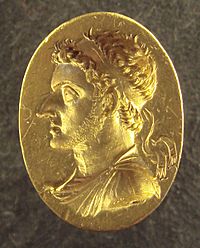
Ptolemy VI was the oldest son of King Ptolemy V and Queen Cleopatra I. His father's early rule was shaped by the Fifth Syrian War (204–198 BC). In this war, the Seleucid king Antiochus III defeated Egypt's forces. He took over some Egyptian lands and made Egypt less powerful. As part of a peace deal, Ptolemy V married Antiochus III's daughter, Cleopatra I, in 194 BC.
Ptolemy VI was born in 186 BC, likely in May or June. He had two siblings: a sister, Cleopatra II, and a younger brother, Ptolemy VIII. His father made it clear that Ptolemy VI was the next in line to the throne. For example, he entered a chariot team in Ptolemy VI's name in the Panathenaic Games of 182 BC.
The loss in the Fifth Syrian War affected the rest of Ptolemy V's rule. Some people in the royal court wanted to go back to war to make Egypt strong again. Others did not want to spend money on rebuilding the army. Ptolemy V died suddenly in September 180 BC, when he was only 30. It's possible he was murdered because of these disagreements.
First Time as King (180–164 BC)
Regents and Royal Marriage
Ptolemy VI was only six years old when he became king. His mother, Cleopatra I, ruled with him. During this time, Cleopatra I's name was often listed before Ptolemy VI's in official papers. Coins were also made with both their names. Cleopatra I wanted peace with the Seleucids because she was from their family. She also knew a war could threaten her power. She likely died in late 178 or early 177 BC.
Ptolemy VI was still too young to rule alone. Before she died, Cleopatra I chose two of her close friends, Eulaeus and Lenaeus, to rule for him. Eulaeus, who had been Ptolemy VI's teacher, was the main ruler. Lenaeus was in charge of the kingdom's money.
Eulaeus and Lenaeus wanted to make Ptolemy VI seem more important. In early 175 BC, they arranged for him to marry his sister, Cleopatra II. Marrying a brother or sister was a tradition in the Ptolemaic royal family. This was probably done to copy earlier Egyptian Pharaohs. Ptolemy VI and Cleopatra II were still young children, so their marriage was not fully started for many years. They would later have at least four children together.
Sixth Syrian War (170–168 BC)
The Seleucid king Seleucus IV, Ptolemy VI's uncle, had generally kept peace. But he was murdered in 175 BC. After a short struggle, his brother Antiochus IV became king. This unstable situation made those who wanted war in Egypt stronger. Eulaeus and Lenaeus could not stop them, especially since Cleopatra I was no longer alive. By 172 BC, Egypt was getting ready for war.
In October 170 BC, Ptolemy VIII was made a co-ruler with his brother and sister. This year was declared the start of a new era. Some historians believe the two brothers represented different groups in the court. These ceremonies were meant to bring unity before the war. Soon after, Ptolemy VI, who was about sixteen, was declared an adult. He had his coming-of-age ceremony. He was now supposed to rule on his own, but Eulaeus and Lenaeus still controlled the government.
The Sixth Syrian War began shortly after, probably in early 169 BC. The Egyptian army marched from the border fort of Pelusium to invade Palestine. But Antiochus IV's army stopped and defeated them in the Sinai. Antiochus took Pelusium and then chased the Egyptians, who had gone back to the Nile Delta.
This defeat caused the Egyptian government in Alexandria to fall apart. Eulaeus tried to send Ptolemy VI to the island of Samothrace with Egypt's treasures. But before this could happen, two important Egyptian generals, Comanus and Cineas, took over the government. As Antiochus IV moved towards Alexandria, Ptolemy VI went to meet him. They made a friendship agreement, which basically made Ptolemy VI a puppet king for the Seleucids.
When people in Alexandria heard about this agreement, they protested. Comanus and Cineas rejected the deal and Ptolemy VI's authority. They declared Ptolemy VIII the only king (Cleopatra II's position stayed the same). Antiochus IV then surrounded Alexandria, but he could not capture the city. He left Egypt in September 169 BC as winter came, leaving Ptolemy VI as his puppet king in Memphis and keeping soldiers in Pelusium.
Within two months, Ptolemy VI made up with Ptolemy VIII and Cleopatra II. He returned to Alexandria. The new government rejected the agreement Ptolemy VI had made with Antiochus IV. They started to get new soldiers from Greece. In response, Antiochus IV invaded Egypt a second time in the spring of 168 BC. He said he was trying to help Ptolemy VI against his younger brother. Antiochus IV quickly took Memphis, where he was crowned king of Egypt. He then moved towards Alexandria.
However, the Egyptian rulers had asked Rome for help during the winter. A Roman group, led by Gaius Popillius Laenas, met Antiochus IV at the town of Eleusis. They forced him to agree to a peace deal, ending the war.
Rebellions and Being Expelled (168–164 BC)
The two brothers and Cleopatra II continued to rule together after the war. But the Egyptian army's complete failure had greatly hurt the royal family's reputation. It also caused a lasting disagreement between Ptolemy VI and Ptolemy VIII.
In 165 BC, Dionysius Petosarapis, an important court official, tried to use the conflict to take control. He went to the stadium and told the people of Alexandria that Ptolemy VI was planning to kill Ptolemy VIII. Ptolemy VI managed to convince his younger brother that this was not true. The two kings appeared together in the stadium, calming the situation. Dionysius ran away and convinced some soldiers to rebel. There was heavy fighting in the Fayyum region for the next year.
Another rebellion, seemingly unrelated, started at the same time in the Thebaid region. This was one of many Egyptian uprisings against the Greek rulers. Ptolemy VI successfully stopped this rebellion after a difficult siege at Panopolis.
Because of the years of fighting, many farms had been left empty. This threatened the government's income from farming. In autumn 165 BC, the rulers issued a royal order, On Agriculture. It tried to force people to farm the land again. This rule was very unpopular and led to many protests. A new government department was created to manage lands that became royal property because they were taken or abandoned.
Late in 164 BC, Ptolemy VIII, who was about twenty years old, somehow forced Ptolemy VI and Cleopatra II out of power. We don't know exactly how this happened. Ptolemy VI fled to Rome to ask for help. He traveled with only a few servants. In Rome, he did not get much help. From there, he went to Cyprus, which he still controlled.
Second Time as King (163–145 BC)
In the summer of 163 BC, the people of Alexandria protested against Ptolemy VIII. They forced him out and called Ptolemy VI back. The king, now back in power, decided to make a deal with his younger brother. He gave Ptolemy VIII control of Cyrenaica. This might have been suggested by two Roman agents who were in Alexandria at the time.
Egypt was now ruled jointly by Ptolemy VI and Cleopatra II. They were both named in all official documents. This way of ruling together, which became common for most of the Ptolemaic family, started with a promise of forgiveness for past actions. It also included a royal visit to Memphis to celebrate the Egyptian new year festival.
Fights with Ptolemy VIII and the Seleucids

Ptolemy VIII was not happy with just Cyrenaica. He went to Rome in late 163 or early 162 BC to ask for help. The Roman Senate agreed that the division was unfair. They said Ptolemy VIII should also get Cyprus. Roman envoys were sent to make Ptolemy VI agree to this, but he delayed and avoided the issue. When they returned to Rome in late 162 BC, they convinced the Senate to stop supporting Ptolemy VI. They also gave Ptolemy VIII permission to use force to take Cyprus. However, the Senate did not give him actual military support. Cyprus remained under Ptolemy VI's control.
In 162 BC, Ptolemy VI also tried to cause problems in the Seleucid kingdom. His agents in Rome helped his cousin Demetrius I escape from prison. Demetrius then returned to Syria to take control of the Seleucid empire from the young king Antiochus V. Once Demetrius I was in power, however, their goals changed, and the chance of war between the two kingdoms returned.
In 154 BC, Ptolemy VIII again asked the Roman Senate for help against Ptolemy VI. This was after he survived an attempt to kill him, which he blamed on his brother. The Senate sent another group of envoys with soldiers to make sure Cyprus was given to Ptolemy VIII. In response, Ptolemy VI surrounded his younger brother at Lapethus and captured him, with help from the Cretan League. He convinced Ptolemy VIII to leave Cyprus. In return, Ptolemy VIII kept Cyrenaica, received a yearly payment of grain, and was promised marriage to one of Ptolemy VI's young daughters (likely Cleopatra Thea) when she was old enough.
Because of the conflict with his brother, Ptolemy VI worked hard to make his oldest son, Ptolemy Eupator, his chosen heir. The young prince became a priest of Alexander and the royal cult in 158 BC, when he was only eight years old. At age fourteen, in spring 152 BC, Ptolemy Eupator was made a full co-ruler with his parents. But he died in the autumn of the same year. This made the future of the throne very uncertain, as Ptolemy VI's other son was very young. He then started to promote his daughter Cleopatra III, officially making her a goddess in 146 BC.
Intervention in Syria (152–145 BC)
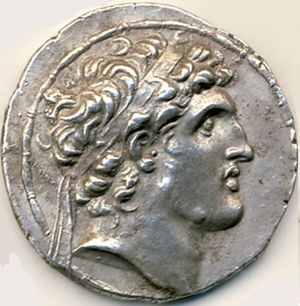
A new person claiming the Seleucid throne, Alexander Balas, appeared in 153 BC. Some historians think Ptolemy VI gave Alexander money, ships, and a safe place to land at Ptolemais Akko. They believe Alexander's chief minister was an Egyptian agent. However, there is no clear proof of this. Other historians say Alexander succeeded on his own at first, without Egypt's help. In any case, Ptolemy VI and Alexander made a deal in 150 BC. Ptolemy VI married his teenage daughter Cleopatra Thea to Alexander in a ceremony at Ptolemais Akko.
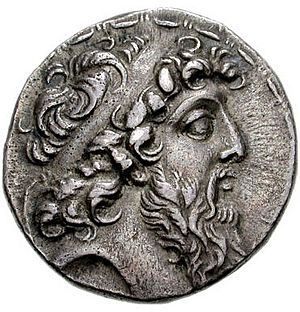
By May 146 BC, Ptolemy VI was gathering soldiers. In 145 BC, he invaded Syria while Alexander was stopping a rebellion in Cilicia. Alexander's helper, Jonathan Maccabee, allowed Ptolemy VI to pass through Judaea without problems. Ptolemy VI said he was helping Alexander against the newest person claiming the Seleucid throne, Demetrius II. But in reality, Ptolemy VI's help came with a high price. He took control of all the Seleucid cities along the coast, including Seleucia Pieria. He might have also started making his own coins in the Syrian cities.
While he was at Ptolemais Akko, Ptolemy VI changed sides. According to the historian Josephus, he found out about a plot to kill him by Alexander's chief minister. When Ptolemy VI demanded that the minister be punished, Alexander refused. Ptolemy VI then remarried his daughter to Demetrius II and continued his march north. The leaders of Antioch gave the city to Ptolemy and crowned him king of Asia. For a short time, documents called him King of Egypt and Asia. He even started counting his rule in Syria as a new era. However, Ptolemy VI worried that uniting the Egyptian and Seleucid kingdoms would make Rome interfere. So, he decided to give up the title. Instead, he only took over the region of Coele Syria. He promised to guide Demetrius II.
Alexander returned from Cilicia with his army. But Ptolemy VI and Demetrius II defeated his forces at the Oenoparas river. Alexander then ran away to Arabia, where he was killed. For the first time since the death of Alexander the Great, Egypt and Syria were united. However, Ptolemy VI had been wounded in the battle and died three days later. By late 145 BC, Demetrius II had forced all Egyptian soldiers out of Syria. He took back Seleucid control by leading his own forces all the way to the Egyptian border. Ptolemy VI likely wanted his seven-year-old son, also named Ptolemy, to become king. But instead, the people of Alexandria invited Ptolemy VIII to take the throne. The young Ptolemy was later removed by his uncle, Ptolemy VIII.
How He Ruled
Pharaoh and Egyptian Religion
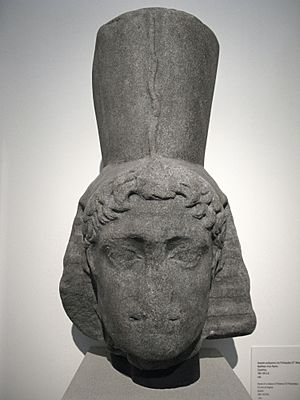
Like the kings before him, Ptolemy VI fully accepted his role as pharaoh. He kept a good relationship with the traditional Egyptian priests. He was especially close to the worship of Ptah and Apis in Memphis. Ptolemy VI and Cleopatra II seemed to visit Memphis every year for the Egyptian New Year festival. During these visits, Ptolemy VI personally made the religious offerings expected of the pharaoh.
In the summer of 161 BC, Ptolemy VI and Cleopatra II gathered all the priests of Egypt. They passed a law that gave tax breaks and other benefits to the priests. In return, the priests gave them special honors in Egyptian temples. This was part of a series of similar laws issued by earlier kings, going back to Ptolemy III. Other writings show specific gifts given at different times during his rule. In September 157 BC, Ptolemy VI confirmed that all tax money from the Dodecaschoenus region would go to the Temple of Isis at Philae. This was first given by the king before him. Around 145 BC, he gave the tribute from a Nubian leader to the priests of Mandulis at Philae.
Relations with the Jewish People
The Jewish historian Josephus says that Ptolemy VI was personally interested in the Jewish people and their well-being. There had been a Jewish community in Egypt since at least the 400s BC. It had grown a lot since Egypt took control of Jerusalem in 311 BC. By Ptolemy VI's time, Jewish people had been part of the Egyptian army for a long time. They had many rights, similar to those of Greeks and Macedonians in Egypt.
A large group of new Jewish immigrants came to Egypt in the 160s BC. They were running away from civil war with the Maccabees. This group was led by Onias IV, whose father had been a high priest but was removed by the Seleucids. Ptolemy VI allowed them to settle at Leontopolis, which became known as the Land of Onias. They also built a temple there with Onias as High Priest. The place is still called Tell al-Jahudija (Hill of the Jews) today. Onias was also given an important military job, and his family became important members of the royal court. In Alexandria, the Jewish people had their own self-governing community. This community was led by their own leader. It is likely that this community was set up under Ptolemy VI.
Relations with Nubia
Until the rule of Ptolemy IV, the Egyptian kings controlled the region south of Aswan to the second cataract (a part of the Nile River). This area was called the Triacontaschoenus or Lower Nubia and had rich gold mines. Throughout the 160s and 150s BC, Ptolemy VI took back control of the northern part of Nubia. This success is greatly shown at the Temple of Isis at Philae. This temple was given the tax money from the Dodecaschoenus region in 157 BC. Decorations on the first large gate of the Temple of Isis at Philae show that the Egyptian kings claimed to rule all of Nubia. The writing about the priests of Mandulis shows that some Nubian leaders were paying tribute to the Egyptian treasury during this time. To keep the region safe, the military governor of Upper Egypt, Boethus, built two new cities. He named them Philometris and Cleopatra to honor the king and queen.
Family and Children
Ptolemy VI and his sister-wife, Cleopatra II, had the following children:
| Name | Image | Birth | Death | Notes |
|---|---|---|---|---|
| Ptolemy Eupator | 15 October 166 BC | August 152 BC | He briefly ruled with his father in 152 BC. | |
| Cleopatra Thea |  |
c. 164 BC | 121/0 BC | She married three Seleucid kings: Alexander I, Demetrius II, and Antiochus VII. She later became a queen in Seleucid Syria. |
| Cleopatra III |  |
160–155 BC? | September 101 BC | She married her uncle Ptolemy VIII. She ruled with her sons Ptolemy IX and Ptolemy X from 116/5–101 BC. |
| Ptolemy | c. 152 BC | 143/141 or 132/1 BC? | He lived longer than his father but was later removed by his uncle, Ptolemy VIII. | |
| Berenice | 160s BC? | Before 133 BC | She was briefly engaged to Attalus III of Pergamum. Her parents and whether she was truly part of the royal family are not fully known. |
See also
 In Spanish: Ptolomeo VI para niños
In Spanish: Ptolomeo VI para niños


